CHEVROLET SUBURBAN 1994 Manual Online
Manufacturer: CHEVROLET, Model Year: 1994, Model line: SUBURBAN, Model: CHEVROLET SUBURBAN 1994Pages: 385, PDF Size: 19.88 MB
Page 81 of 385
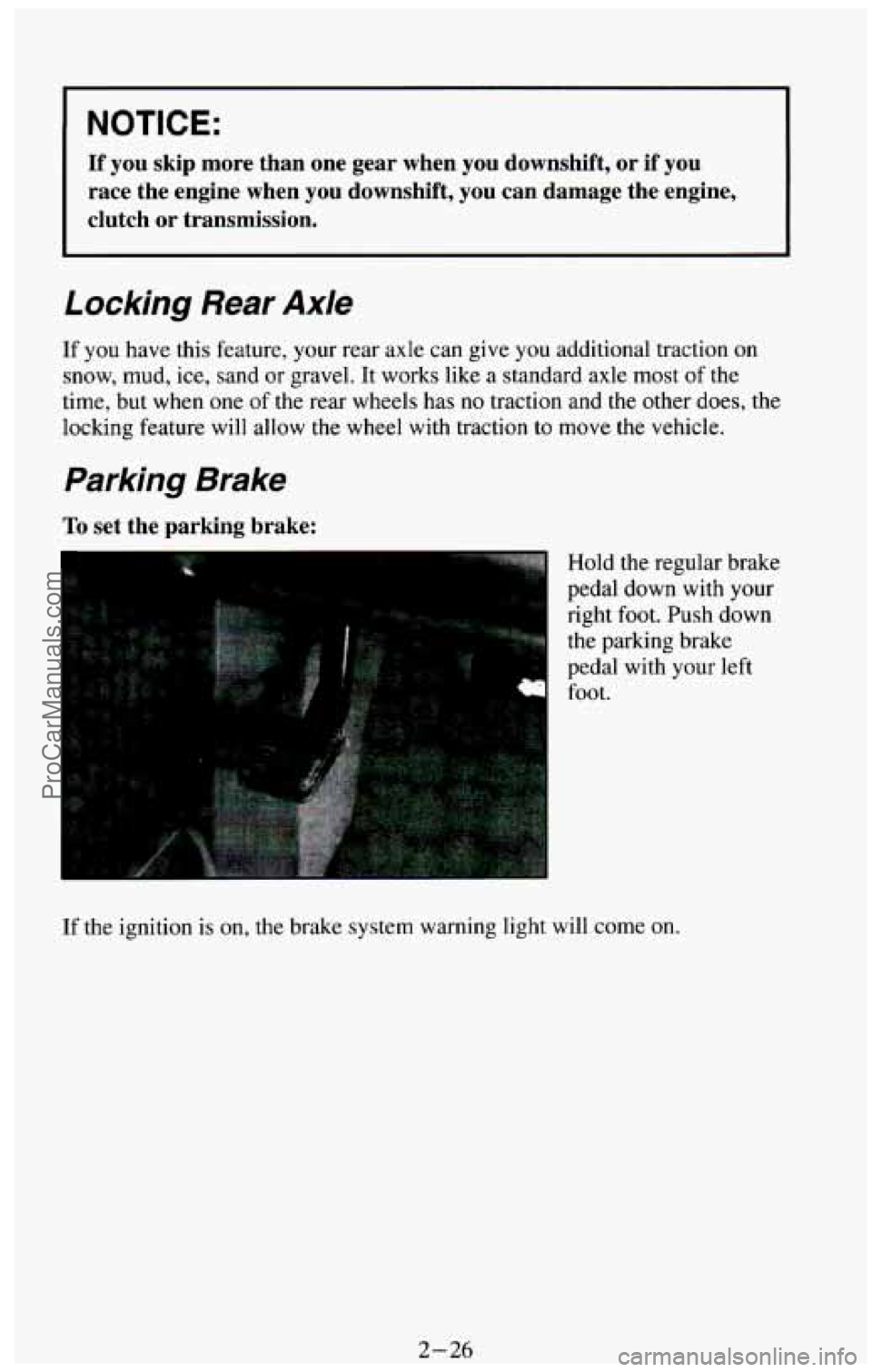
I NOTICE:
If you skip more than one gear when you downshift, or if you
race the engine when you downshift, you can damage the engine,\
clutch
or transmission.
Locking Rear Axle
If you have this feature, your rear axle can give you additional traction on
snow, mud, ice, sand or gravel. It works like a standard axle most of the
time, but when one
of the rear wheels has no traction and the other does, the
locking feature will allow the wheel with traction to move the vehicle.
Parking Brake
To set the parking brake:
Hold the regular brake
pedal down with your
right foot. Push down
the parking brake
pedal with
your left
foot.
If the ignition is on, the brake system warning light will come on.
2-26 ProCarManuals.com
Page 82 of 385
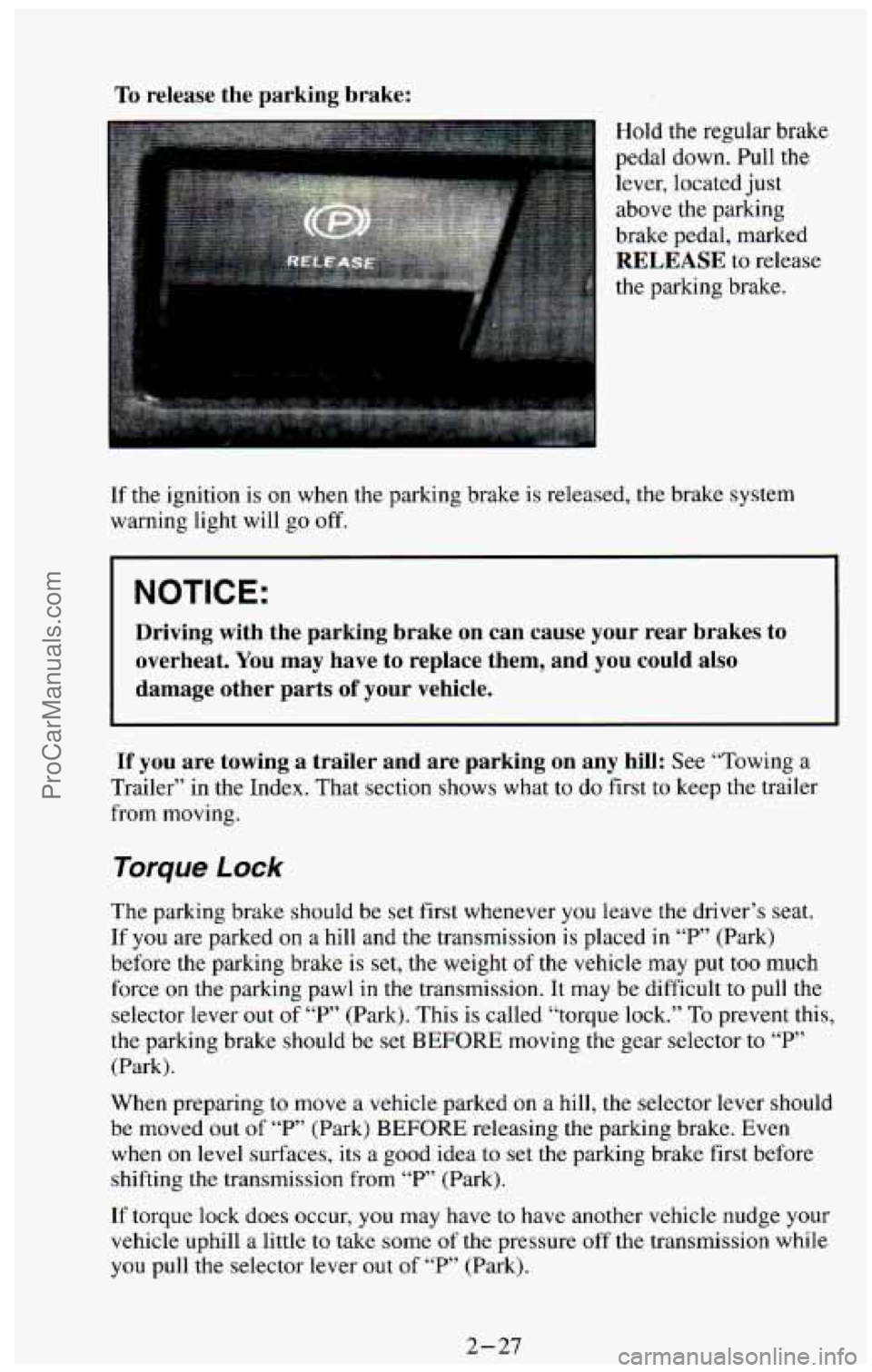
To release the parking brake:
Hold the regular brake
pedal down. Pull the
lever, located just
above the parking
brake pedal, marked
RELEASE to release
the parking brake.
If the ignition is on when the parking brake is released, the brake system
warning light will
go off.
NOTICE:
Driving with the parking brake on can cause your rear brakes to
overheat. You may have to replace them, and you could also
damage other parts
of your vehicle.
If you are towing a trailer and are parking on any hill: See “Towing a
Trailer” in the Index. That section shows what to do first to keep the trailer
from moving.
Torque Lock
The parking brake should be set first whenever you leave the driver’s seat.
If you are parked on a hill and the transmission is placed in “P’ (Park)
before the parking brake is set, the weight
of the vehicle may put too much
force on the parking pawl in the transmission. It may be difficult to pull the
selector lever out
of “P” (Park). This is called “torque lock.” To prevent this,
the parking brake should be set
BEFORE moving the gear selector to “P”
(Park).
When preparing to move a vehicle parked on a hill, the selector lever should
be moved out
of “P” (Park) BEFORE releasing the parking brake. Even
when on level surfaces, its a good idea to set the parking brake first before
shifting the transmission from
“P” (Park).
If torque lock does occur, you may have to have another vehicle nudge your
vehicle uphill a
little to take some of the pressure off the transmission while
you pull the selector lever
out of “P’ (Park).
2-27
ProCarManuals.com
Page 83 of 385
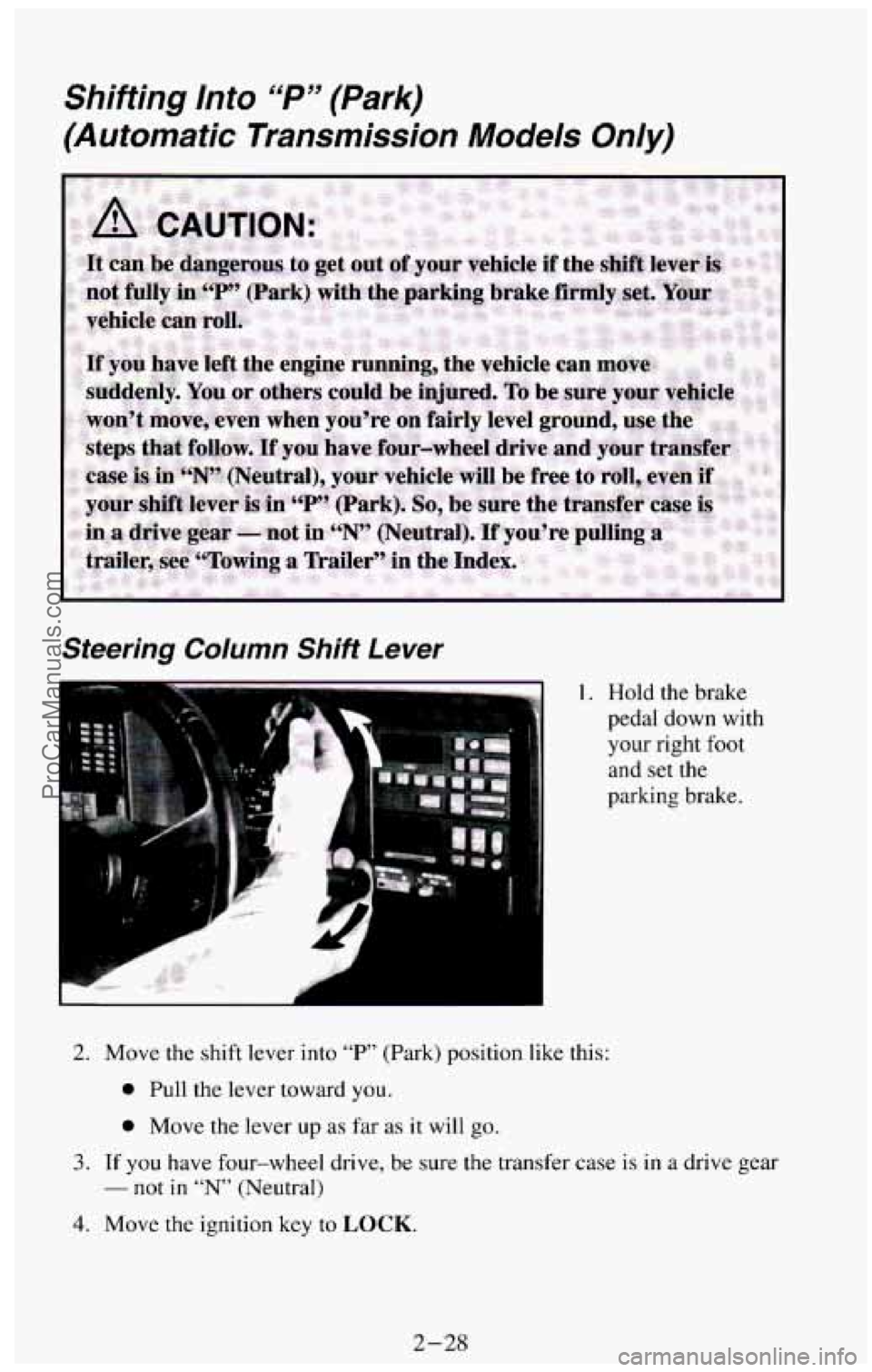
Shifting Into “P” (Park)
(Automatic Transmission Models Only)
Steering Column Shift Lever
1. Hold the brake
pedal down with
your right
foot
and set the
parking brake.
2. Move the shift lever into “P” (Park) position like this:
0 Pull the lever toward you.
0 Move the lever up as far as it will go.
3. If you have four-wheel drive, be sure the transfer case is in a drive gear
- not in “N’ (Neutral)
4. Move the ignition key to LOCK.
2-28
ProCarManuals.com
Page 84 of 385
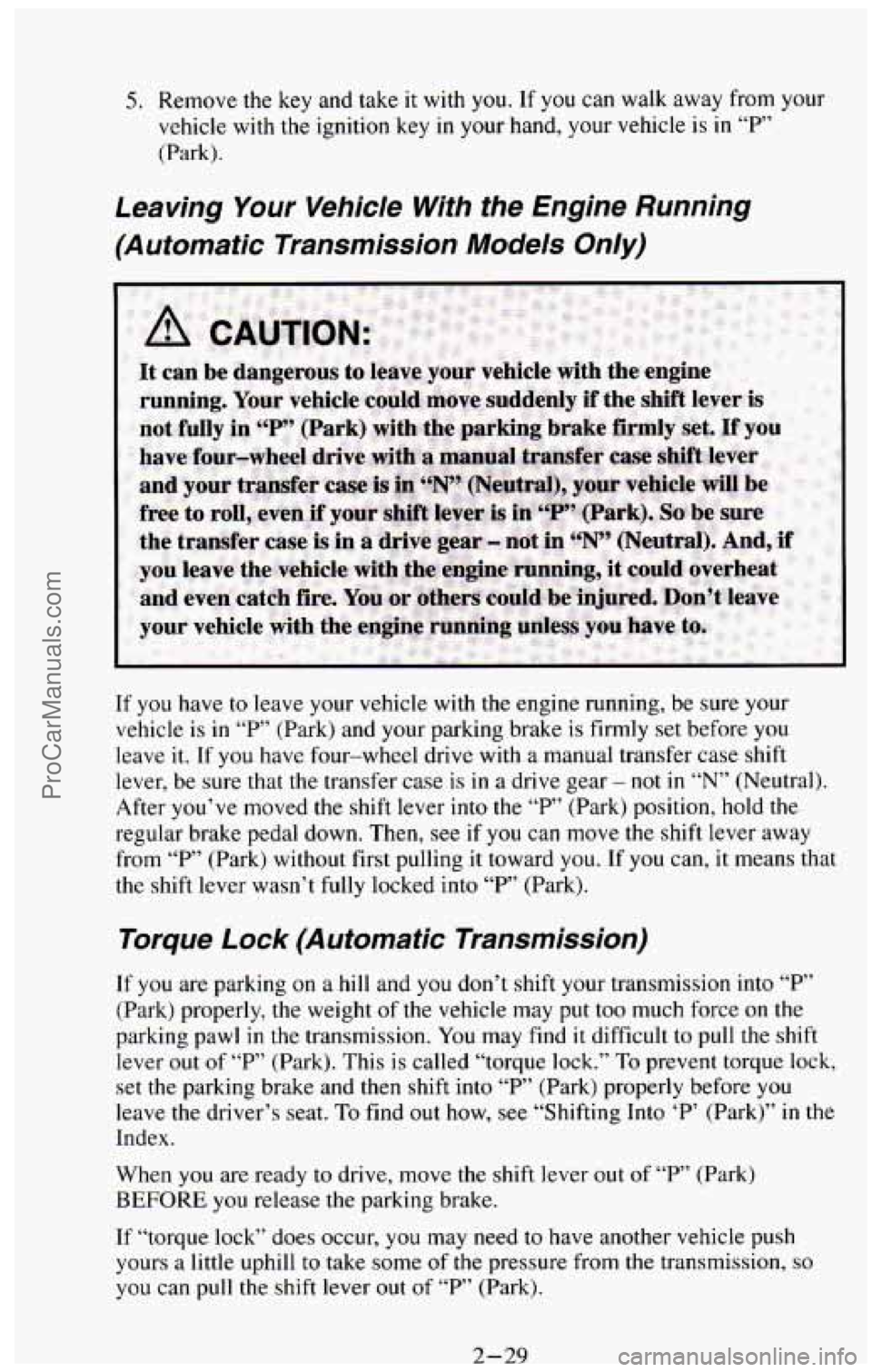
5. Remove the key and take it with you. If you can walk away from your
vehicle with the ignition key in
your hand, your vehicle is in “P”
(Park).
If
you have to leave your vehicle with the engine running, be sure your
vehicle
is in “P’ (Park) and your parking brake is firmly set before you
leave it. If
you have four-wheel drive with a manual transfer case shift
lever, be sure that
the transfer case is in a drive gear - not in “N” (Neutral).
After
you’ve moved the shift lever into the “P” (Park) position, hold the
regular brake pedal down. Then, see if
you can move the shift lever away
from “P” (Park) without first pulling it toward you. If
you can, it means that
the shift lever wasn’t fully locked into
“I?” (Park).
Torque Lock (Automatic Transmission)
If you are parking on a hill and you don’t shift your transmission into “P”
(Park) properly, the weight of the vehicle may put
too much force on the
parking pawl in the transmission. You may find it difficult to pull the shift
lever
out of “P” (Park). This is called “torque lock.’’ To prevent torque lock,
set the parking brake and then shift into
“P’ (Park) properly before you
leave the driver’s seat. To find out how, see “Shifting Into ‘P’ (Park)” in the
Index.
When
you are ready to drive, move the shift lever out of “P” (Park)
BEFORE you release the parking brake.
If “torque lock”
does occur, you may need to have another vehicle push
yours a little uphill to take some
of the pressure from the transmission, so
you can pull the shift lever out of “F”’ (Park).
2-29 ProCarManuals.com
Page 85 of 385
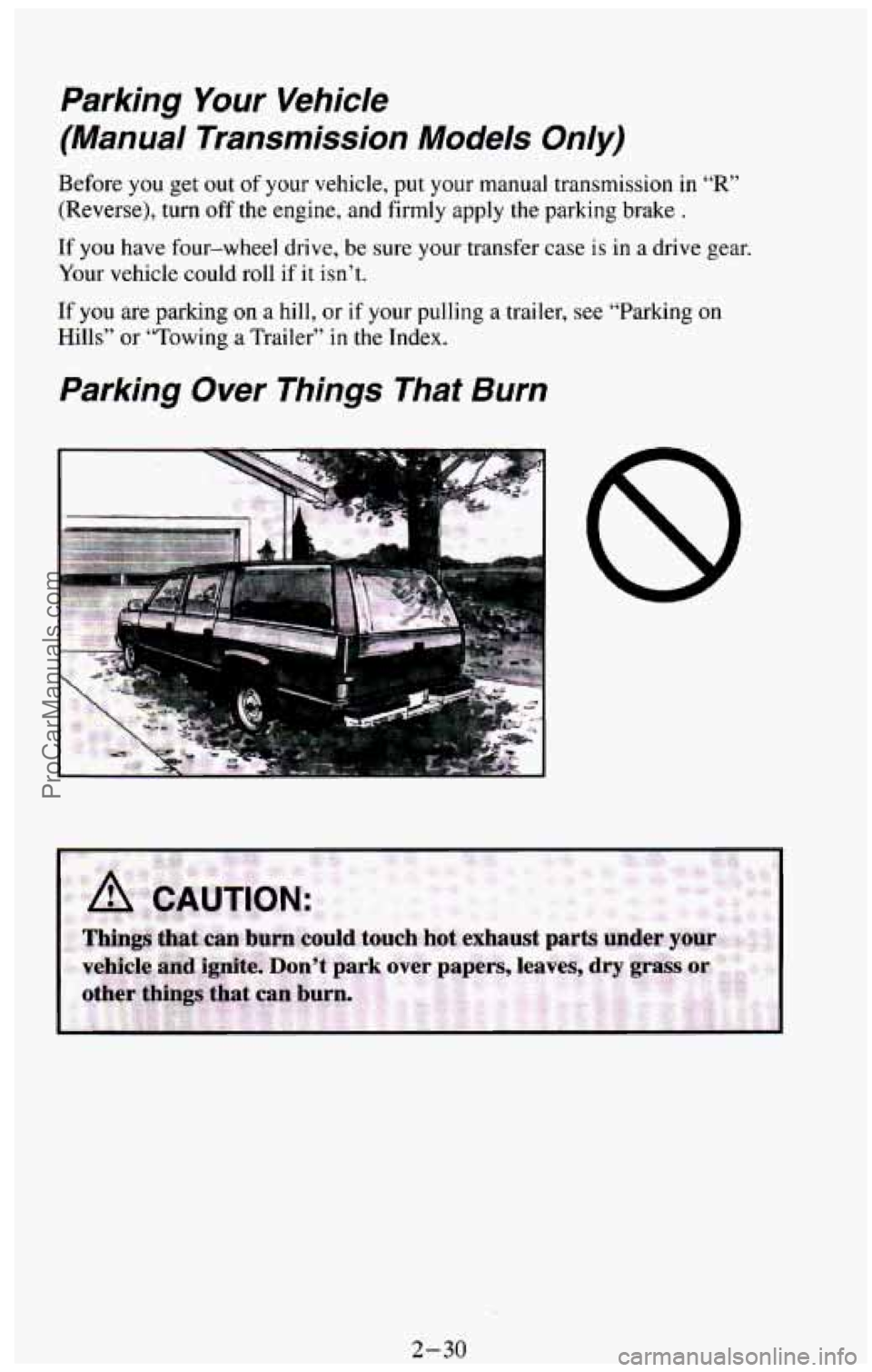
Parking Your Vehicle
(Manual Transmission Models Only)
Before you get out of your vehicle, put your manual transmission in “R”
(Reverse), turn off the engine, and firmly apply the parking brake .
If you have four-wheel drive, be sure your transfer case is in a drive gear.
Your vehicle could roll
if it isn’t.
If you are parking on a hill, or if your pulling a trailer, see “Parking on
Hills” or “Towing a Trailer’’ in the Index.
Parking Over Things That Burn
2-30 ProCarManuals.com
Page 86 of 385
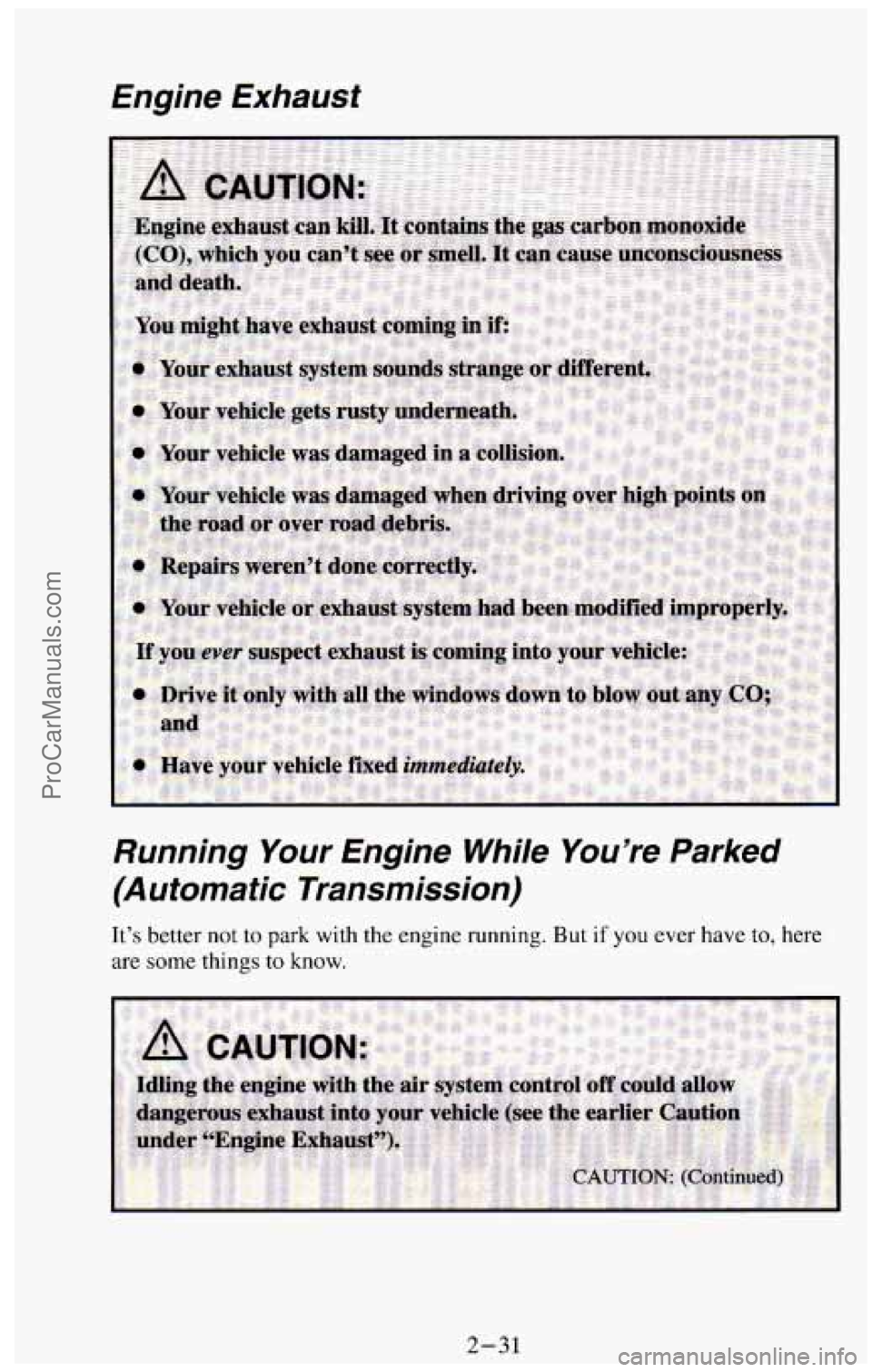
Engine Exhaust
Running Your Engine While You’re Parked
(Automatic Transmission)
It’s better not to park with the engine running. But if you ever have to, here
are
some things to know.
2-31
ProCarManuals.com
Page 87 of 385
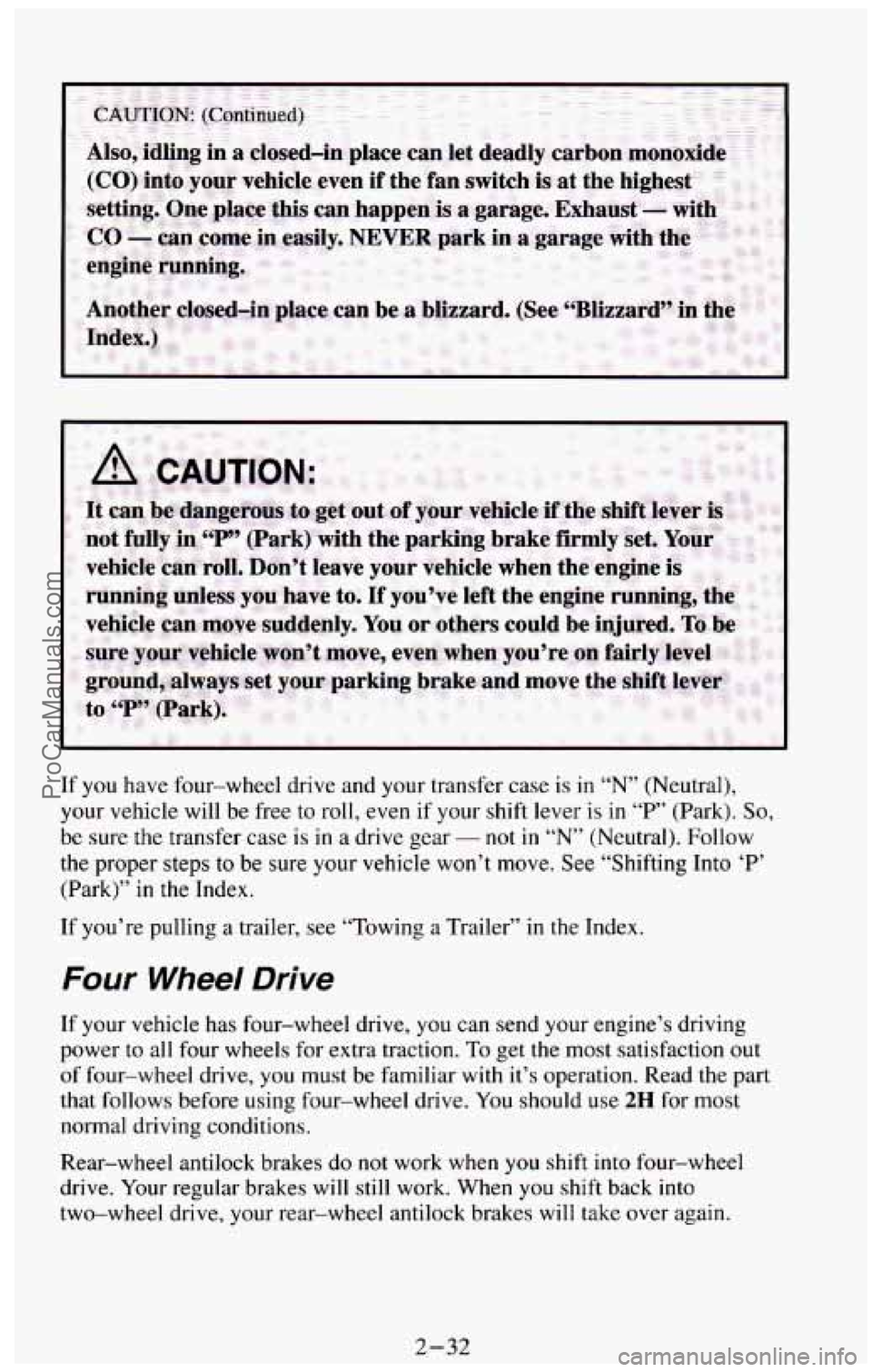
If you have four-wheel drive and your transfer case is in “N” (Neutral),
your vehicle will be free to roll, even if your shift lever is in
“P” (Park). So,
be sure the transfer case is in a drive gear - not in “N” (Neutral). Follow
the proper steps
to be sure your vehicle won’t move. See “Shifting Into ‘P’
(Park)” in the Index.
If you’re pulling a trailer, see “Towing a Trailer” in the Index.
Four Wheel Drive
If your vehicle has four-wheel drive, you can send your engine’s driving
power
to all four wheels for extra traction. To get the most satisfaction out
of four-wheel drive, you must be familiar with it’s operation. Read the part
that follows before using four-wheel drive.
You should use 2H for most
normal driving conditions.
Rear-wheel antilock brakes do
not work when you shift into four-wheel
drive. Your regular brakes will
still work. When you shift back into
two-wheel drive, your rear-wheel antilock brakes will take over again.
2-32
ProCarManuals.com
Page 88 of 385
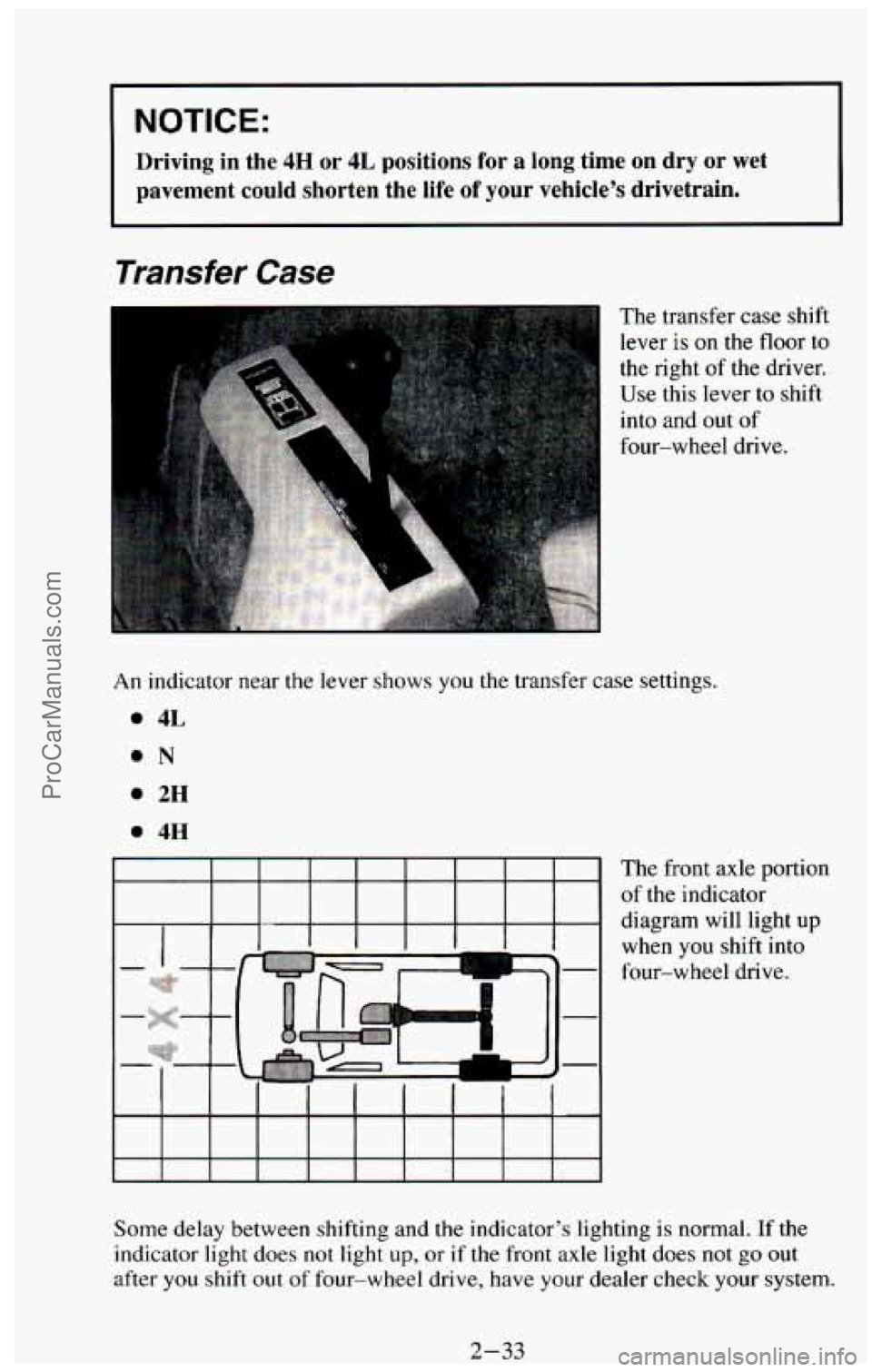
NOTICE:
Driving in the 4H or 4L positions for a long time on dry or wet
pavement
could shorten the life of your vehicle’s drivetrain.
Transfer Case
The transfer case shift
lever
is on the floor to
the right
of the driver.
Use this lever to shift
into and out
of
four-wheel drive.
An indicator near the lever
shows you the transfer case settings.
The front axle portion
of the indicator
diagram will light
up
when you shift into
four-wheel drive.
Some delay between shifting and the indicator’s lighting
is normal. If the
indicator light does
not light up, or if the front axle light does not go out
after
you shift out of four-wheel drive, have your dealer check your system.
2-33 ProCarManuals.com
Page 89 of 385
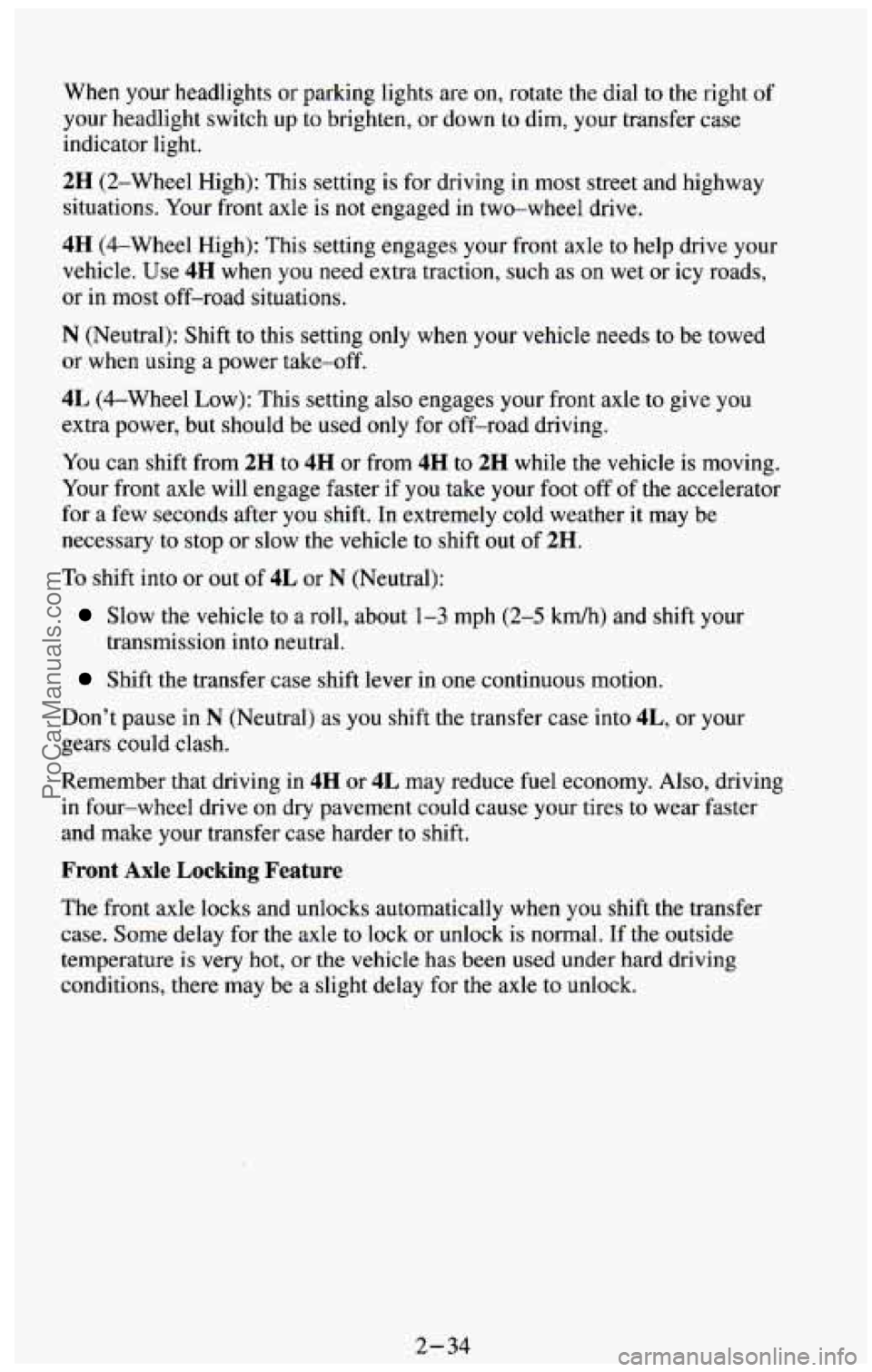
When your headlights or parking lights are on, rotate the dial to the right of
your headlight switch up to brighten, or down to dim, your transfer case
indicator light.
2H (2-Wheel High): This setting is for driving in most street and highway
situations. Your front axle
is not engaged in two-wheel drive.
4H (&Wheel High): This setting engages your front axle to help drive your
vehicle. Use
4H when you need extra traction, such as on wet or icy roads,
or
in most off-road situations.
N (Neutral): Shift to this setting only when your vehicle needs to be towed
or when using a power take-off.
4L (4-Wheel Low): This setting also engages your front axle to give you
extra power, but should be used only for off-road driving.
You can shift from
2H to 4H or from 4H to 2H while the vehicle is moving.
Your front axle will engage faster if
you take your foot off of the accelerator
for a few seconds after you shift. In extremely cold weather
it may be
necessary to stop or slow the vehicle to shift out of
2H.
To shift into or out of 4L or N (Neutral):
Slow the vehicle to a roll, about 1-3 mph (2-5 kdh) and shift your
Shift the transfer case shift lever in one continuous motion.
transmission into neutral.
Don’t pause
in N (Neutral) as you shift the transfer case into 4L, or your
gears could clash.
Remember that driving in
4H or 4L may reduce fuel economy. Also, driving
in four-wheel drive on dry pavement could cause your tires to wear faster
and make your transfer case harder to shift.
Front Axle Locking Feature
The front axle locks and unlocks automatically when you shift the transfer
case. Some delay for the axle to lock or unlock is normal. If the outside
temperature is
very hot, or the vehicle has been used under hard driving
conditions, there may be a slight delay for the axle to unlock.
2-34
ProCarManuals.com
Page 90 of 385
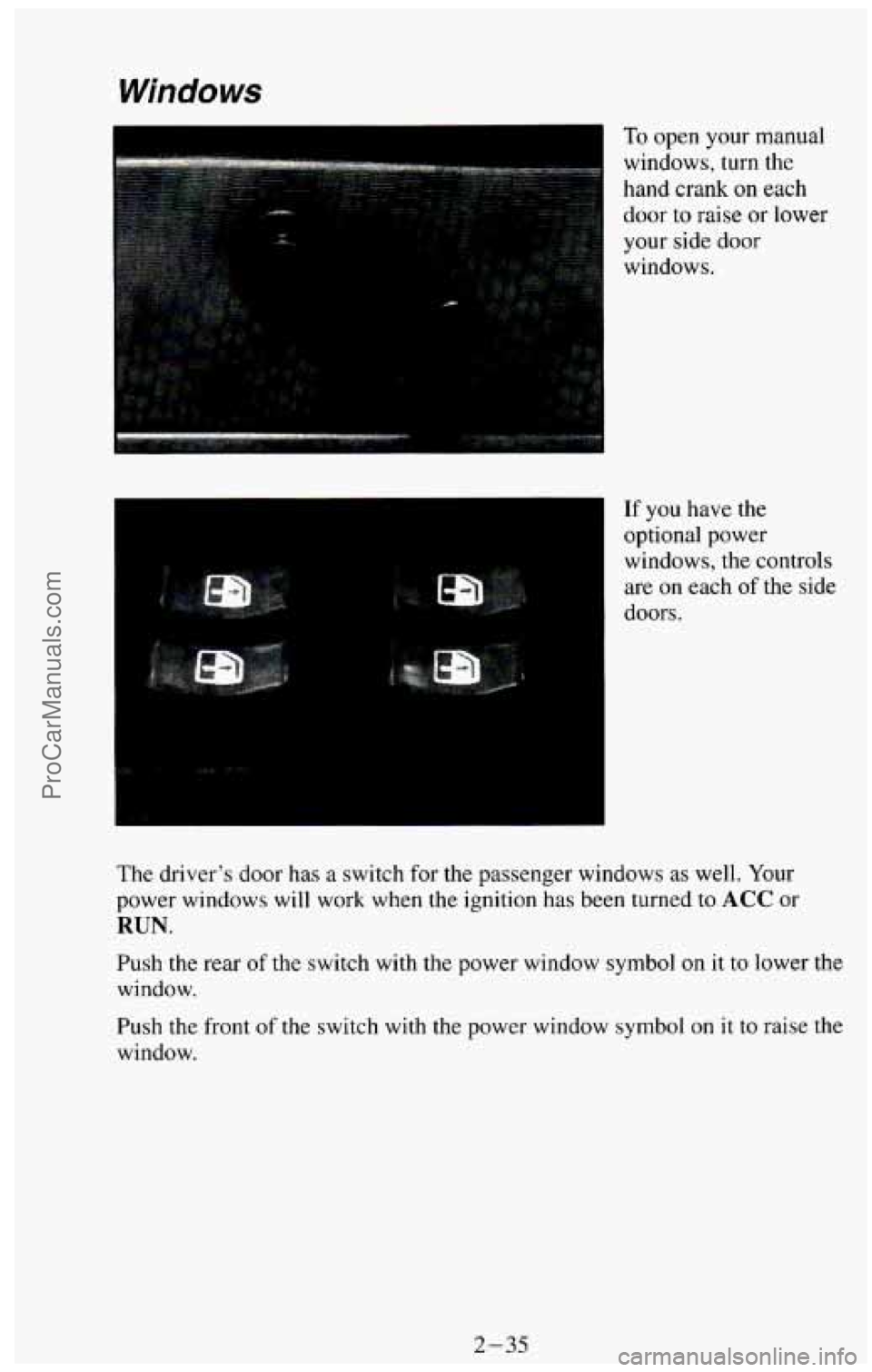
Windows
To open your manual
windows, turn the
hand crank
on each
door to raise or lower
your side door
windows.
If you have the
optional power
windows, the controls
are on each
of the side
doors.
The driver’s door has a switch for the passenger windows
as well. Your
power windows will work when the ignition has been turned to ACC or
RUN.
Push the rear of the switch with the power window symbol on it to lower the
window.
Push the front
of the switch with the power window symbol on it to raise the
window.
2-35
ProCarManuals.com